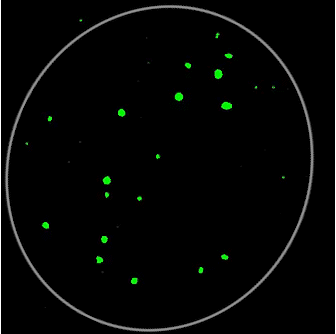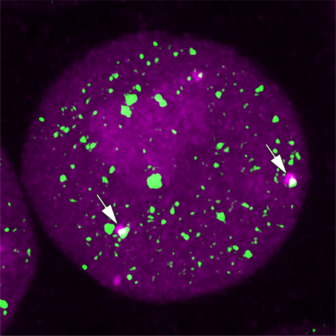RNA Intrigues Biologist Jonathan Henninger
Jonathan Henninger seeks to discover things that change how the field of biology thinks. He said the Department of Biological Sciences at Carnegie Mellon University is the right place to conduct his research.
Henninger joined the faculty as an assistant professor in January of 2024. He investigates how cells control gene expression, the process where instructions encoded in DNA are copied to RNA and used to make proteins. He studied blood regeneration and cancer using zebrafish as a model organism during his Ph.D. at Harvard University. He and his colleagues introduced mutations found in human blood cancers and tracked mutant blood cells over time to learn how cancer progresses. The researchers identified a gene involved in inflammation that cancer cells express but typical cells do not, which gives the cancer cells a competitive edge.
“When we knocked out that gene, the mutant cancer cells were unable to expand, keeping the blood in a healthy state,” he said. This work inspired Henninger to dive more deeply into studying mechanisms that control gene expression and the fate of a cell. He joined the Whitehead Institute for Biomedical Research at MIT as a postdoctoral fellow to pursue this goal. Henninger and his team discovered that the RNA molecules born during the early stages of gene expression are intimately involved in their own production.
“We found that newly transcribed RNA can bind to proteins involved in gene expression and affect protein recruitment to genes, which enables RNA itself to tinker with its own production.” Henninger now wants to understand how RNA regulates gene expression and cell fate in health and disease. “I want to understand the deep, inner workings of a cell and really understand what’s happening with RNA. We’re in an RNA era.”
Henninger, whose lab members chart their favorite songs in a playlist called “Henn-singers,” said researchers across many fields are taking a deeper look at ribonucleic acid, also known as RNA. He said these “founding molecules of life have been deeply underappreciated” until recently. This shift in understanding for RNA has led to a tremendous body of research in biology, chemistry, and in the clinic. He uses techniques from molecular biology, soft-matter physics and super-resolution microscopy to investigate how RNA regulates genes and contributes to cell fate.
In particular, he studies what happens when things go awry as cells take shape and how the cells lose their identity during early stages of disease. His goal is to help scientists understand how RNA contributes to normal gene expression, and how defects in this process contribute to human disease.
“My lab also aims to learn how we get a cell to take up an RNA therapy, how we can use RNA to regulate the cellular processes we want,” he said.
Using a suite of tools in molecular biology, the Henninger Lab engineers DNA and RNA in cultures of cells — including mouse stem cells, human kidney cells, and human cancer cells — to study how the RNA forms from the DNA and gets to work. As the cells turn genes on and off to maintain or change their cellular identify and behavior, the RNA behaves in ways scientists are still working to understand.
Scientists understood for a long time that the inner bits of each cell were surrounded by membranes and kept to themselves. Henninger said that proteins, DNA, and RNA molecules can glob together without membranes like oil droplets in salad dressing. The field calls these structures biomolecular condensates.
“The polymers that interact to form condensates are dynamic,” Henninger said. “RNA creates a self-regulating process as it’s being produced to control condensate formation, modifying instructions inside the cell on the fly. Then the structures dissolve when the RNA is done.”
Being at Carnegie Mellon allows him to collaborate with leading researchers in gene expression, medicinal chemistry and machine learning to help analyze the huge datasets being collected that capture complex biology.
“I am so eager to build collaborations with deep learning researchers to help analyze the grammar of these RNA processes,” he said.
In the meantime, he’s rounding out his own interdisciplinary interests learning about the visualization and communication of his work. Henninger tinkers with graphics programs such as Adobe Illustrator and Blender to create colorful, dynamic graphics showing new understandings of a cell’s inner life. Studying the works of artists like Leonardo da Vinci, Henninger has learned different techniques to attract the eye, including chiaroscuro, the use of light and dark highlights, and sfumato, or the blurring between colors to make things look more natural, to generate mesmerizing models of RNA and proteins.
His artistic efforts are inspired by the microscopy images he collects of fluorescent biomolecules in cells, where neon green protein blobs dance across the black screen with magenta RNA in mesmerizing assemblies — RNA transcription in real time.
“I find it all so compelling,” Henninger said.

